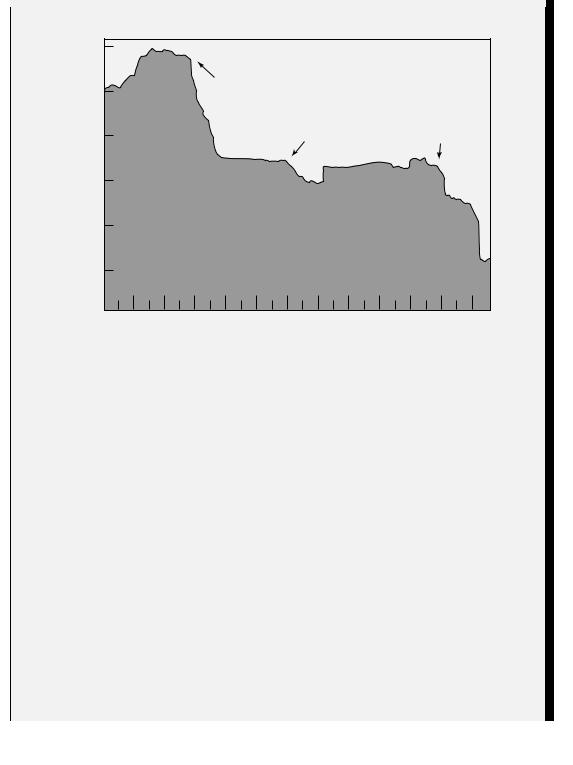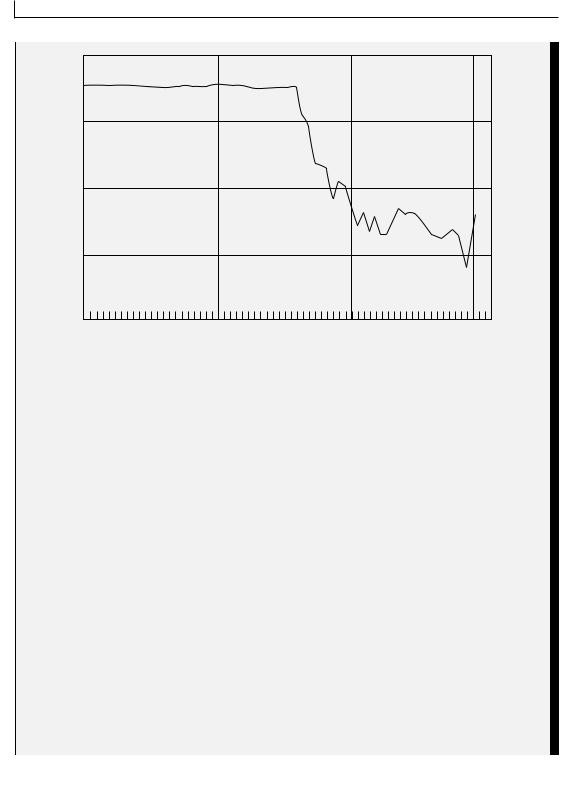
Global corporate finance - Kim
.pdf
102 THE INTERNATIONAL MONETARY SYSTEM
Global Finance in Action 4.2
Europe’s Ambitious Bid for a More Perfect Union
At a summit in Greece on June 20, 2003, European heads of state inspected the latest EU draft constitution. The draft aims to emulate the Founding Fathers of the USA. If the draft becomes the legal foundation of Europe, it would create a perfect union of the 25 member states as of 2004. These 25 states have a combined population of 450 million and an economy nearly 90 percent as large as that of the USA.
One of the long-term French goals has been to give the EU a common foreign and defense policy. The draft reflects that goal by proposing a powerful “foreign minister” and requiring that member states unreservedly support the union’s policies in “a spirit of loyalty and solidarity.” Some heads of member governments suspect that the purpose here is to fulfill the Gaullist dream of Europe becoming a world power that would rival the USA. Their fears were reinforced when France opposed the US invasion of Iraq in early 2003.
Source: George Melloan, “Europe’s Ambitious Bid for a More Perfect Union,” The Wall Street Journal, June 17, 2003, p. A17.
4.5 Proposals for Further International Monetary Reform
The Bretton Woods system had three basic defects: (1) pegged parities, (2) dollar disequilibrium, and (3) inadequate international reserves. Some important reforms introduced to solve these problems include special drawing rights, the Smithsonian Agreement, the snake within a tunnel, and the EMS. Nevertheless, these reforms were inadequate to maintain orderly markets.
4.5.1Volatile exchange rates
When major industrial countries abandoned the fixed exchange rate system in 1973 in favor of a floating-rate system, they saw their decision as a triumph for the free market. Many economists expected exchange rates to be fairly stable under the flexible exchange rate system. They also expected that the flexible exchange rate system would reduce national trade imbalances. Major exchange rates have been more volatile since 1974. The trade imbalances of many countries have been larger and more persistent since 1974.
In other words, the costs of flexible exchange rates have been greater than expected. Consequently, a consensus has grown that the world should return to stable but flexible policy rules. These and other problems have recently increased the need for further international monetary reform. Proposals for further international monetary reform may be divided into two broad categories: proposals for greater flexibility and other proposals.
PROPOSALS FOR FURTHER INTERNATIONAL MONETARY REFORM |
103 |
|
|
4.5.2Proposals for greater flexibility
A system of additional flexibility, or even a system of freely flexible exchange rates, has been suggested to restructure the current international monetary system so that deficit countries might solve their payments problems. It seems reasonable to assume that fixed exchange rates, which existed under the gold standard before World War I, are now practically impossible. Moreover, fixed but adjustable exchange rates could not accommodate highly diversified modern economies more than one half-century after the Bretton Woods Agreement. Countries differ too much in price levels, wage costs, monetary policies, and international capital flows to keep fixed exchange rates.
A WIDER BAND A wider band has been frequently suggested as an alternative to the present international monetary system. The Bretton Woods Agreement allowed a band of 2.25 percent, and the Smithsonian Agreement approved a band of 4.5 percent. Proponents of this wider band would like to see it expanded further. They argue that a wider band would allow central banks to enjoy freedom to pursue independent monetary policies.
THE CRAWLING PEG The crawling peg is a proposal that would provide for regular modification of par value according to an agreed-upon formula. Under this system, a country would permit its currency to appreciate or depreciate slowly, rather than fight to maintain a band of certain percentages around par value. The crawling peg would provide relatively stable exchange rates for those nations, which consider this stability essential for international transactions. Balance-of-payments problems would also be self-adjusted through the international price mechanism rather than through exchange controls, restrictions on the growth of national income and employment, price controls, or other unpopular internal policies.
THE CRAWLING BAND A crawling band combines a wider band and a crawling peg. In other words, this proposal is a compromise between the inflexible exchange rates of the gold standard and a system of completely fluctuating exchange rates. Each parity level would be adjusted upward or downward as a moving average of the actual exchange rates that could fluctuate within a wider band: (1) within 1 year, the exchange rate parity would be allowed to move a predetermined maximum – say, 2 percent – and this 2 percent is called the annual crawling peg; (2) this slowly crawling peg would be surrounded by a wider band within which the actual exchange rate could fluctuate.
4.5.3Other proposals
A number of proposals ask for the creation of a super-central institution that would perform the same function for an international economy as the commercial banking system performs for a domestic economy. John Keynes (Machlup 1964), for instance, proposed the establishment of an International Clearing Union that would create an international currency called the “bancor.” Under this system, deficit countries would be able to borrow bancors to finance their deficits.
To illustrate another viewpoint, Robert Triffin (1968) proposed the creation of reserves by an international institution such as the IMF. Under this proposal, surplus countries would be required to deposit a portion of their holdings in key currencies (dollars, special drawing rights,

104 THE INTERNATIONAL MONETARY SYSTEM
yen, and pounds) in the IMF instead of holding them as monetary reserves. On the basis of these deposits, the IMF could create necessary international monetary reserves through its loans to deficit countries.
Another proposal calls for enlarging the number of reserve countries. To reduce exchange risk, many central banks have recently diversified their portfolios of reserve assets to include Japanese yen, euros, special drawing rights, and gold. An increased number of reserve countries would spread the reserve-currency burden more evenly than before and leave the monetary system less vulnerable to attack. Freely flexible exchange rates, discussed in the earlier part of this chapter, have been frequently suggested to reform the international monetary system. Completely flexible exchange rates have never been tried. It is unlikely that they ever will be.
SUMMARY
Financial managers must understand the international monetary system if they are to manage multinational businesses efficiently. Foreign-exchange rates determine the prices of goods and services that multinational companies buy and sell across national boundaries. These exchange rates also have an impact on foreign investments.
Considered historically, the international monetary system of the late nineteenth century evolved into the current dirty floating system. The pre-1914 gold standard represents one extreme of the international monetary system. Under this system, the exchange rate for each currency was fixed in terms of gold. The flow of gold restored the balance-of-payments equilibrium. In the case of a deficit, a gold outflow would take place to finance an external deficit. In the case of a surplus, a gold inflow would occur to eliminate an external surplus.
World War I ended the stability of exchange rates for currencies of major trading partners. The world then experienced international monetary disorder from 1914 to 1945. The Great Depression of 1929–32 and the international financial crisis afterwards resulted in international monetary chaos. To summarize the international monetary system from 1914 to 1945, we find a mixture of widely fluctuating exchange rates and controlled exchange rates.
The Bretton Woods Agreement of 1944 marked a new era for the operation of the international monetary system, which was a system of fixed exchange rates based on a revised gold standard, called the gold exchange standard. Each currency was fixed within a narrow range of value in relation to gold or the US dollar. Many member countries were unable or unwilling to abide by the Bretton Woods Agreement, because its provisions were complex and because their interests conflicted. Nevertheless, the Bretton Woods Agreement and the activity of the IMF were the main features of the international monetary system from 1945 to 1973.
Two problems raised serious questions about the function of the Bretton Woods Agreement as the international monetary system. First, the growth of monetary reserves was inadequate. Second, effective balance-of-payments adjustments could not be achieved under the Agreement. Attempts to save the Bretton Woods Agreement through the introduction of SDRs and the Smithsonian Agreement failed when the whole system collapsed in 1973. Since 1973, the international monetary system has been characterized by a confusing mixture of freely floating, managed floating, joint floating, and fixed rates.

REFERENCES 105
Questions
1Some governments and economists have repeatedly suggested that the international monetary system return to a system of fixed exchange rates. Discuss the pros and cons of the fixed exchange rate system.
2Why did the US dollar become so weak and the Bretton Woods Agreement fail in 1973?
3Analysts said that President Nixon’s speech delivered on August 15, 1971 was designed to prepare Americans for a multipolar world, because American decline – both economically and militarily – was inevitable. List the decisions announced in this famous speech.
4List those events that would change a country’s demand for and supply of foreign exchange.
5What are some alternative exchange rate systems?
6List the objectives of the International Monetary Fund (IMF).
7What are special drawing rights (SDRs)? How is the value of the SDR determined?
8What is a currency board? What are the solid fundamentals in order to have a successful currency board? How did the currency board that pegged the Argentinian peso to the US dollar during the 1990s affect Argentina’s current account and thus its economy?
9What is dollarization? What are the arguments for and against dollarization?
10When do volatile exchange rates exist?
11The major industrialized countries have practiced the floating exchange rate system since 1973. Under the floating-rate system, economists expected exchange rates to be fairly stable and trade imbalances to fall. Have these two expectations been realized?
12What are the advantages of a common currency such as the euro?
REFERENCES
Antinolfi, G. and T. Keister, “Dollarization as a Monetary Arrangement for Emerging Market Economies,” Review, Federal Reserve Bank of St. Louis, Nov./Dec. 2001, pp. 29–39.
Bloughten, J. M., Fifty Years After Bretton Woods: The Future of IMF and World Bank, Washington, DC: International Monetary Fund, 1995.
Cooper, R. N., The International Monetary System: Essays in World Economics, Cambridge, MA: The MIT Press, 1987.
Hickman-Riggs, L. and W. A. Riggs, “The Creation of the Euro,” Management Accounting Quarterly, Spring 2001, pp. 35–40.
Kim, S. H. and M. Haque, “The Asian Financial Crisis of 1997: Causes and Consequences,”
Multinational Business Review, Spring 2002, pp. 37–44.
Kim, Y. S., “Rationale for An Asian Monetary Fund,” The Journal of Korean Economy, Fall 2001, pp. 229–48.
Kopcke, R. W., “Currency Boards: Once and Future Monetary Regimes,” New England Economic Review, May/June 1999, pp. 21–37.
Machlup, F., Plans for Reform of the International Monetary System, Princeton, NJ: Princeton University Press, 1964.

106 THE INTERNATIONAL MONETARY SYSTEM
Metzer, A. H., “Asian Problems and the IMF,” The Cato Journal, Winter 1998, pp. 267–8.
Sesit, M. R., “Dollar Face Further Pressure under US Deficits, Protectionism,” The Wall Street Journal, Jan. 2, 2004, p. R13.
Triffin, R., Our International Monetary System: Yesterday, Today, and Tomorrow, New York: Random House, 1968.
White, J. A., “Flexible Exchange Rates: An Idea Whose Time Has Passed?” Economic Review, Federal Reserve Bank of Atlanta, Sept./Oct. 1990, pp. 2–15.
Wynne, M. A., “The European System of Central Banks,” Economic Review, Federal Reserve Bank of Dallas, First Quarter 1999, pp. 2–13.
Case Problem 4: The Mexican Peso Crisis of
December 1994
Before the December 1994 devaluation, the Mexican government had essentially pegged the peso to the US dollar through its exchange rate stabilization program. Mexico permitted its exchange rate to fluctuate within a band of 2 percent. However, in December 1994 Mexico faced a balance-of-payments crisis. Investors lost confidence in Mexico’s ability to maintain the exchange rate of the peso within its trading band, in part because of Mexico’s large current-account deficit, which had reached almost $28 billion in that year. Intense pressure on the peso in foreign-exchange markets threatened to exhaust Mexico’s international reserves. This pressure eventually compelled the Mexican government to float the peso and led to the now-famous peso crisis between December 1994 and early 1995.
Exchange rate stabilization programs by developing countries are very difficult to pursue effectively over protracted periods. In programs such as that of Mexico, devaluation is not unusual, even when care is taken to address the typical problems by using exchange rate pegging as only a part of the overall program. After taking office on December 1, 1988, President Carlos Salinas used “pegging” as an important element of a broader program that included reduced government spending, tax reform, deregulation, privatization, and significant trade liberalization – including rapid reductions in tariffs and quotas through entries into the General Agreement on Tariffs and Trade (GATT), into the North American Free Trade Agreement (NAFTA), and into the Organization for Economic Cooperation and Development (OECD). This broader economic program reduced the number of government-owned enterprises from 1,100 in 1987 to 220 in 1994, decreased inflation from 159 percent in 1987 to 7 percent in 1994, eliminated the nation’s budget deficit, increased exports to the USA by 35 percent, and cut wage increases in half between 1987 and 1994. The real sector of the Mexican economy was healthy, not sick.
The key, then, was not to balance the current account with the rest of the world, but to balance trade deficits with voluntary investment inflows. Mexico ran current-account deficits of $25 billion in 1992 and $23 billion in 1993, and during this time not only maintained the peso at around $3.1, but accumulated large foreign reserves. In 1994, the current-account deficit was only slightly higher – $27 billion after 11 months. The problem came with the inflows, as political turmoil shook investor confidence.

|
CASE PROBLEM 4 |
107 |
|
|
|
|
|
|
|
|
|
|
|
|
|
$ millions
30,000 |
|
Colosio assassination |
|
25,000 |
|
Carpizo |
|
resignation |
Ruiz mass |
threat |
resignation |
20,000 |
|
15,000
10,000
5,000
0
J F M A M J J A S O N D
1994
Figure 4.7 Mexican international reserves in 1994
The biggest shock came in March 1994, when presidential candidate Luis Colosio was assassinated. Ernesto Zedillo, who had been Salinas’s Planning and Budget Minister, was Colosio’s hastily selected replacement; he was elected in August as the new president. Colosio’s killing, a year-long peasant rebellion in southern Mexico, and the September 1993 assassination of the ruling party secretary Francisco Ruiz had combined to weaken international investor confidence, while creating an image of Mexico as politically unstable. Consequently, foreign-exchange reserves had fallen from a peak of $30 billion before the Colosio assassination on March 23 to about $12 billion at the Zedillo inauguration on December 1 (see figure 4.7).
Mexico decided to devalue, widening the bands on the exchange rate on December 20 and going to a freely floating rate on December 22. The latter decision was actually forced, because the earlier one collapsed as investor confidence in the peso disappeared. Widening the bands clearly presaged devaluation and led to a massive capital flight from the peso, and loss of $6 billion – or half of the remaining reserves – in one day. Judging by their public economic plans, the Mexican authorities had in mind an exchange rate of 4.07 pesos to the dollar, a 14 percent devaluation from the earlier 3.50 floor. But with confidence imploding, the peso dropped immediately to 5.80, a 40 percent devaluation (see figure 4.8).

108THE INTERNATIONAL MONETARY SYSTEM
3
4
5
6
7
November |
December |
January |
Feb. |
1994 |
|
1995 |
|
Figure 4.8 Mexican pesos per US dollar (inverted scale)
Case Questions
1Normally, economists suggest that exchange rate pegging by developing countries such as Mexico ought to be a temporary stabilization tool, ultimately followed by a managed float, a crawling band, or a floating exchange rate system. Briefly define each of these three exchange regimes.
2Approximately $24 billion had fled Mexico in a run on the peso between April 1 and December 21, 1994. What is capital flight? How does it differ from capital flows? What were the major causes of capital flight in Mexico?
3Explain the Mexican rescue package of $50 billion arranged by the USA and the International Monetary Fund to avert a broader financial crisis.
4In making this unusual commitment (a $50 billion rescue package), was the world unintentionally rewarding Mexican mismanagement? What was to keep the same problems from causing another financial crisis that would require another rescue plan in the future?
5Given all of Mexico’s problems, how risky was the US $20 billion aid package?

|
CASE PROBLEM 4 |
109 |
|
|
|
|
|
|
|
|
|
|
|
|
|
6The home page of the International Monetary Fund (IMF), www.imf.org, provides IMFrelated news, their contracts, and an update on their most recent activities. Use this web page to find out about current IMF loans to its member countries.
Sources: T. Carrington, “Some Questions and Answers About Clinton’s New Plan to Aid Mexico,” The Wall Street Journal, Feb. 2, 1995, p. A5; T. Carrington, T. D. Rogers, and R. Wartzman, “Clinton Hastily Drops Mexican Rescue Plan, Gives New Aid Instead,” The Wall Street Journal, Feb. 1, 1995, pp. A1, A6.

PART II
Corporate Foreign-Exchange
Risk Management
In 1997, two American finance professors – Robert Merton of Harvard University and Myron Scholes of Stanford University – received the Nobel Prize in economics for their groundbreaking work on option pricing that helped spawn the present $100 trillion derivatives industry. In the early 1970s, Professor Scholes invented an insightful method of pricing options and warrants at a time when investors and traders still relied on educated guesses to determine the value of various stock market products. Professor Merton later demonstrated the broad applicability of this options-pricing formula, which led to the incredible growth in the derivatives market.
Part II (chapters 5–10) explains relationships between exchange rates and economic variables, with an emphasis on foreign-exchange risk management. This part covers not only the spot market but also the derivatives market. Currency derivatives – forwards, futures, options, futures options, and swaps – are contracts whose values are derived from the prices of underlying currencies. They are offered through two channels: organized exchanges and over-the-counter markets. Organized exchanges such as the Chicago Mercantile Exchange and similar exchanges around the world have expanded their menu of products. Over-the-counter (OTC) markets, such as banks and some other financial institutions, also offer and are willing to tailor make these products for their customers. Before we consider currency derivatives separately in coming chapters, we will describe the key derivatives terminology below.
Derivatives and Terminology
cap An option that protects the buyer from a rise in a particular interest rate above a certain level.
collar The simultaneous purchase of a cap and sale of a floor, with the objective of maintaining interest rates within a defined range.
dealer A counterparty that enters into a swap in order to earn fees or trading profits, serving customers as an intermediary.
